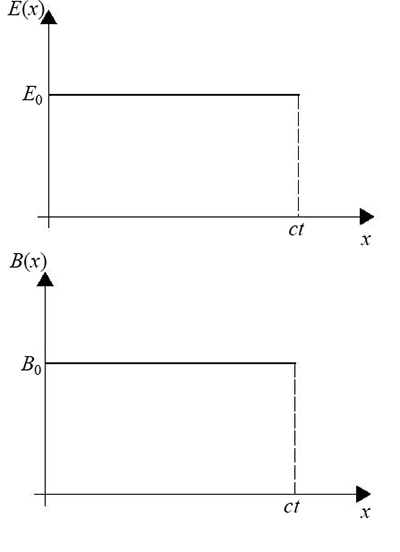Electromagnetic Waves in a Vacuum
Problem 1
Two parallel strips of metal of negligible resistance have width \( w \) and length \( D \). They are separated by a distance \( d \) with \( d \ll w \) and \( w \ll D \). At time \( t = 0 \) a constant potential difference, \( V_0 \), is applied across the two strips at the left end of the strips and kept at \( V_0 \) for all \( t >0 \). The system is shown in the figure below.

Choose some instant of time, \( t = T>0 \), such that the voltage across the two strips at the far end is still zero. You may ignore the fringe fields. At time \( t = T \):
- Plot the magnitude of the electric field, \( \mathbf{E} \), and magnetic field, \( \mathbf{B} \) (between the strips) as a function of the longitudinal position along the strips.
- What are the directions of the vectors \( \mathbf{E} \) and \( \mathbf{B} \)?
- Compute the power supplied by the voltage source.
› View/Hide Hint
› View/Hide Answers
Problem 2
Sunlight with B-field \(\vec{B} = 10^{-6} (B_x, 2, 0) \cos ( \omega t - k_x x + k_y y)\) webers/m\(^2\), where \(k_x = 8\pi /a\), \(k_y = 6\pi/a\) and a = 2500 nanometers, shines on a mirror-like polar ice lying in the \(x\)-\(z\) plane. The area of the ice is 100,000 square kilometers.
- Find \(B_x\), the direction, the wavelength and the frequency of the incident sunshine;
- Find the E-field of the incident sunshine;
- Find the Poynting vector of the incident sunshine;
- Find the reflected E-field;
› View/Hide Hint
- Find the total E-field;
- Due to global warming, this piece of ice has just melted, exposing the totally absorbing black rocks underneath. How much additional energy per second is the Earth absorbing due to this melted ice? How does it compare with the average electrical power consumption of the world (about four times the US power consumption, which is the average power consumption per person times the US population)?
› View/Hide Answers

